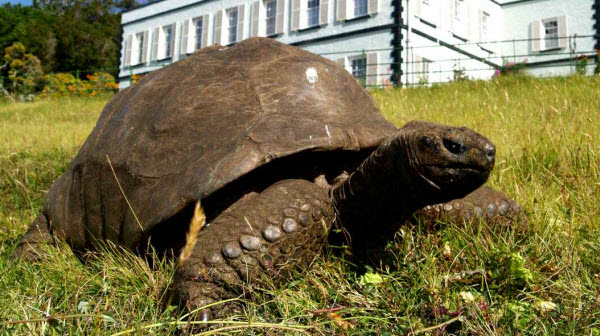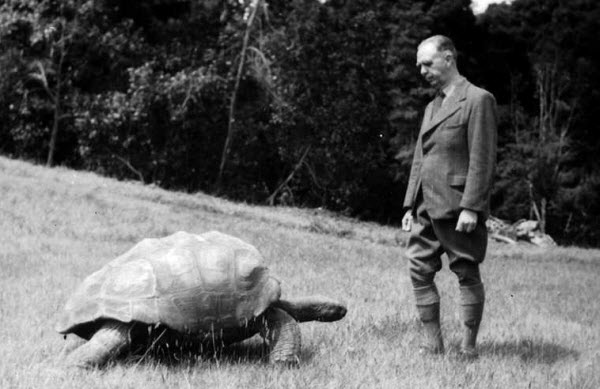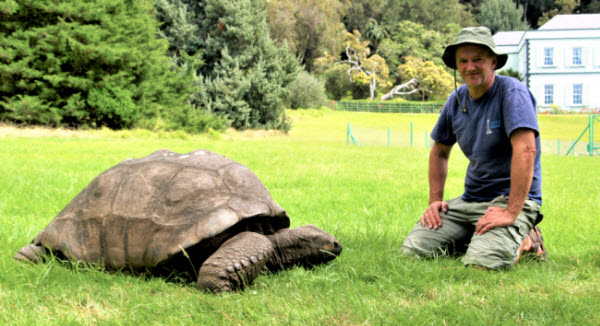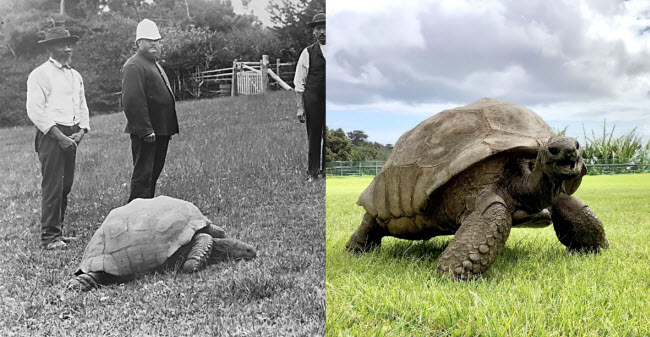Our world is often filled with peculiarities, particularly in the animal kingdom, which includes one of the oldest living creatures on Earth—the tortoise Jonathan. Jonathan began his life in the early 19th century and is now approaching 190 years old. His value extends beyond being merely a long-lived animal; he is considered a living witness to world history and its changes. He has witnessed both World Wars, the rise and fall of 40 U.S. Presidents, the collapse of the Russian Tsarist regime and the Bolshevik takeover, Adolf Hitler’s rise to power in Germany, and his invasion of Europe, until his eventual defeat. This makes Jonathan a focal point for biologists eager to uncover the secrets behind his remarkable longevity.
Jonathan resides with other tortoises amid the gum trees that resonate with birdsong at the Plantation House, the official residence of the Governor of the British Overseas Territories in the South Atlantic, on the island of Saint Helena. This island was once the exile of the famous French leader Napoleon Bonaparte, and it was a site where many victims of the slave trade, both sick and dying, spent their last hours. In the 17th century, it was a trading post for the East India Company and is home to a diverse population of Europeans, Americans, Africans, and Asians. No one knows exactly why Jonathan ended up on this island, given that he is a rare member of a subspecies of the giant Aldabra tortoises native to the Seychelles in the Indian Ocean. It is believed that ships coming to Saint Helena carried hundreds of tortoises as a source of food. Fortunately for Jonathan, he became the property of Hudson Janisch, the island’s governor in the 1880s.

Despite the succession of 33 governors on the island, Jonathan has remained at the official residence, receiving the care and attention he deserves. Although no one knows his exact birthdate, it is widely believed that he was brought to the island at the age of 50 in 1882, which would make his hatching year 1832, five years before Queen Victoria’s coronation. There are many stories suggesting that Jonathan might have met Napoleon Bonaparte on the island, but this is inaccurate. Although there was a giant tortoise during Napoleon’s time, it was not Jonathan, and no records indicate that they ever met, especially since Napoleon never visited the governor’s residence. However, Jonathan’s birth predates many of humanity’s notable inventions, including the first postage stamp, introduced eight years after his birth, and the first electric light, which appeared when he was 47. He also witnessed the construction of the first skyscraper in 1885, followed by the completion of the Eiffel Tower two years later, a national landmark in France. Jonathan remained unnamed throughout his time on the island until the 1930s when Governor Spencer Davis gave him his name.

Jonathan has become a local celebrity to the extent that his image appears on the five-pence coin. He attracted global media attention in 2008 when the Daily Mail published his story with a vintage photograph said to be from 1900, claiming he was then 176 years old and the world’s oldest living animal. In his youth, Jonathan was quite active, frequently escaping from his enclosure and traversing any fence to reach the church. He later became known for disrupting croquet games by sitting on the balls and flipping chairs by tennis courts, a behavior attributed to loneliness. This led Governor Dermod Murphy to request companions from the Seychelles, resulting in the arrival of two tortoises, Emma and David, both 54 years old, and later, Frederick, 31. Given his advanced age and the expectation of his death at any time, detailed plans were made for his passing, including writing an obituary and planning his burial while preserving his shell for display in Saint Helena. Contrary to expectations, Jonathan remains in good health and maintains a strong appetite. However, he is blind due to cataracts from aging and has lost his sense of smell, making it difficult for him to find food. His companions often steal his food, prompting people around him to assist with feeding. Despite his loss of sight and smell, Jonathan retains excellent hearing.

Jonathan’s precise weight is unknown as no device can weigh him, but some scientists estimate it to be between 150 and 200 kg. Despite living on the island for over 140 years, he has not produced any offspring, leading scientists to believe he may be either infertile or asexual. They also speculate that Jonathan’s extraordinary longevity might be due to the effects of “monkey ear” plants, a common herb on Saint Helena with round leaves resembling monkey ears. Known for its diuretic properties and its ability to detoxify, reduce inflammation and fever, and boost healing and immunity, it is used in China to make tea. This herb may have contributed to Jonathan’s longevity.
